Mineralogical Insights to Identify Göktepe Marble in the Sculptural Program of Quinta Das Longas Villa (Lusitania)
Abstract
:1. Introduction
2. Materials and Methods
3. Results and Discussion
3.1. Petrography, XRPD and CL-Optical Observations
3.2. Quantitative CL-SEM
3.3. C and O Isotopes
3.4. Sr and Mn Concentration
3.5. EPR Parameters
3.6. 87Sr/86Sr Parameter
4. Archaeological Considerations
5. Conclusions
Author Contributions
Funding
Data Availability Statement
Acknowledgments
Conflicts of Interest
References
- Carvalho, A.; de Almeida, M.J. A uilla romana da Quinta das Longas (S. Vicente e Ventosa, Elvas): Uma década de trabalhos arqueológicos (1991–2001). Cidade Rev. Cult. Portalegre 2002, 13–14, 13–37. [Google Scholar]
- Nogales Basarrate, T. Ciclos escultóricos de la villa de Quinta das Longas. Talleres de Afrodisias en Hispania. In Barcino-Tarraco-Roma. Poder i Prestigi en Marbre; Garcia-Moreno, G.A., Gorostidi, D., Eds.; Homenaje a Isabel Rodà: Tarragona, Spain, 2021. (In press) [Google Scholar]
- Nogales Basarrate, T.; Gonçalves, L.; Lapuente, P. Materiales lapídeos, mármoles y talleres en Lusitania. In Marmora Hispana: Explotación y uso de los Materiales Pétreos en la Hispania Romana; Hispania Antigua (Serie Arqueológica 2); Nogales, T., Beltrán, J., Eds.; L’Erma di Bretschneider: Rome, Italy, 2008; pp. 407–466. [Google Scholar]
- Taelman, D.; Elburg, M.; Smet, I.; de Paepe, P.; Lopes, L.; Vanhaecke, F.; Vermeulen, F. Roman marble from Lusitania: Petrographic and geochemical characterization. J. Archaeol. Sci. 2013, 40, 2227–2236. [Google Scholar] [CrossRef] [Green Version]
- Lapuente, P.; Nogales-Basarrate, T.; Royo, H.; Brilli, M. White marble sculptures from the National Museum of Roman Art (Mérida, Spain): Sources of local and imported marbles. Eur. J. Mineral. 2014, 26, 333–354. [Google Scholar] [CrossRef]
- Nogales Basarrate, T.; Lapuente, P.; Royo, H.; Preite-Martinez, M. Stone materials in Lusitania Reflecting the Process of Romanization. In Interdisciplinary Studies on Ancient Stone, ASMOSIA X; Pensabene, P., Gasparini, E., Eds.; L’Erma di Bretschneider: Rome, Italy, 2015; pp. 253–262. [Google Scholar] [CrossRef]
- Carvalho, A.; de Almeida, M.J. A agua e o mármore na villa baixo-imperial da Quinta das Longas. (S. Vicente e Ventosa, Elvas) Elvas–Caia. Rev. Int. Cult. Cienc. 2003, 1, 113–126. [Google Scholar]
- Nogales Basarrate, T.; Carvalho, A.; de Almeida, M.J. El programa decorativo de la Quinta das Longas (Elvas, Portugal): Un modelo excepcional de las uillae de la Lusitania. In Actas de la IV Reunión sobre Escultura Romana en Hispania; Nogales Basarrate, T., Goncalves, L.J., Eds.; Universidade de Lisboa: Lisboa, Portugal, 2004; pp. 103–156. [Google Scholar]
- Antonelli, F.; Lazzarini, L. An updated petrographic and isotopic reference database for white marbles used in antiquity. Rend. Lincei-Sci. Fis. 2015, 26, 399–413. [Google Scholar] [CrossRef]
- Yavuz, A.B.; Attanasio, D.; Elçi, H.; Brilli, M.; Bruno, M. The discovery of previously unknown ancient marble quarries in the Göktepe region of Mugla (western Turkey). In Leukos Lithos: Marbres et Autres Roches de la Méditerranée Antique. Études Interdisciplinaires, ASMOSIA VIII; Jockey, P., Ed.; Maisonneuve & Larose: Paris, France, 2009; pp. 93–109. [Google Scholar]
- Attanasio, D.; Bruno, M.; Yavuz, A.B. Quarries in the region of Aphrodisias: The black and white marbles of Göktepe (Muğla, Turkey). J. Roman Archaeol. 2009, 22, 312–348. [Google Scholar] [CrossRef]
- Lapuente, M.P.; León, P.; Nogales, T.; Royo, H.; Preite Martinez, M.; Blanc, P. White sculptural materials from Villa Adriana: Study of provenance. In Interdisciplinary Studies on Ancient Stone, Proceedings of the IX ASMOSIA Conference, Tarragona, Spain, 8–13 June 2009; Gutiérrez Garcia, M.A., Lapuente, P., Rodà, I., Eds.; ICAC: Tarragona, Spain, 2012; pp. 364–375. [Google Scholar]
- Lapuente, P.; León, P.; Nogales-Basarrate, T. Variedades de mármol escultórico de Villa Adriana. Un ejemplo de estudio arqueométrico. In Roma, Tibur, Baetica. Investigaciones Adrianeas; Hidalgo, R., León, P., Eds.; Universidad de Sevilla: Sevilla, Spain, 2013; pp. 210–225. [Google Scholar]
- Attanasio, D.; Bruno, M.; Prochaska, W.; Yavuz, A.B. A multi-method database of the black and white marbles of Göktepe (Aphrodisias), including isotopic, EPR, trace and petrographic data. Archaeometry 2015, 57, 217–245. [Google Scholar] [CrossRef]
- Brilli, M.; Lapuente Mercadal, M.P.; Giustini, F.; Royo Plumed, H. Petrography and mineralogy of the white marble and black stone of Göktepe (Muğla, Turkey) used in antiquity: New data for provenance determination. J. Archaeol. Sci. Rep. 2018, 19, 625–642. [Google Scholar] [CrossRef] [Green Version]
- Prochaska, W.; Attanasio, D.; Bruno, M. Unraveling the Carrara-Göktepe entanglement. In Interdisciplinary Studies of Ancient Stone, Proceedings of the 11th International Conference of ASMOSIA, Split, Croatia, 18–22 May 2015; Poljak, D.M., Marasović, K., Eds.; University of Split: Split, Croatia, 2018; pp. 175–183. [Google Scholar]
- Wielgosz-Rondolino, D.; Antonelli, F.; Bojanowski, M.J.; Gładki, M.; Göncüoğlu, M.C.; Lazzarini, L. Improved methodology for identification of Göktepe white marble and the understanding of its use: A comparison with Carrara marble. J. Archaeol. Sci. 2020, 113, 105059. [Google Scholar] [CrossRef]
- Lazzarini, L. Recensione di Attanasio et al. 2009. Marmora 2010, 6, 169–171. [Google Scholar]
- Attanasio, D.; Bruno, M.; Yavuz, A.B. La realtà del marmo afrodisiense di Goktepe: Replica ad una recensionem. Marmora 2011, 7, 119–122. [Google Scholar]
- Lazzarini, L. Controreplica alla replica della mia recensione. Marmora 2011, 7, 123–124. [Google Scholar]
- Attanasio, D.; Bruno, M.; Prochaska, W.; Yavuz, A.B. Comments on the paper “Petrography and mineralogy of the white marble and black stone of Göktepe (Muğla, Turkey) used in antiquity: New data for provenance determination” by M. Brilli, M.P. Lapuente Mercadal, F. Giustini and H. Royo Plumed (JAS Reports 2018, 19, 625–642). J. Archaeol. Sci. Rep. 2020, 30, 102070. [Google Scholar] [CrossRef]
- Brilli, M.; Lapuente Mercadal, M.P.; Giustini, F.; Royo Plumed, H. Reply to Comments on the paper “Petrography and Mineralogy of the white marble and black stone of Göktepe (Muğla, Turkey) used in antiquity: New data for provenance determination” by M. Brilli, M.P. Lapuente Mercadal, F. Giustini and H. Royo Plumed (JAS Reports 2018, 19, 625–642). J. Archaeol. Sci. Rep. 2020, 30, 102071. [Google Scholar] [CrossRef]
- Lapuente, P.; Royo, H. Cathodoluminescence for the characterization of ancient marble. Problems and research perspective. In Ancient Quarries and Building Sites in Asia Minor. Research on Hierapolis in Phrygia and Other Cities in South-Western Anatolia: Archaeology, Archaeometry, Conservation; Ismaelli, T., Scardozzi, G., Eds.; Edipuglia: Bari, Italy, 2016; pp. 541–548. [Google Scholar] [CrossRef]
- Blanc, P.; Lapuente Mercadal, M.P.; Garcia-Moreno, G.A. A new database of the quantitative cathodoluminescence of the main quarry marbles used in antiquity. Minerals 2020, 10, 381. [Google Scholar] [CrossRef]
- Poretti, G.; Brilli, M.; De Vito, C.; Conte, A.M.; Borghi, A.; Günther, D.; Zanetti, A. New considerations on trace elements for quarry provenance investigation of ancient white marbles. J. Cult. Herit. 2017, 28, 16–26. [Google Scholar] [CrossRef]
- Garcia-Moreno, G.A.; Savin, M.-C.; Lapuente, P.; Florian, P.; Franceschi, M.; Chapoulie, R.; Pianet, I. MNR as a new tool for Cultural Heritage Application: The provenance of ancient white marbles. Archaeometry 2019, 61, 795–808. [Google Scholar] [CrossRef]
- Pianet, I.; Garcia-Moreno, G.A.; Savin, M.-C.; Lapuente, P.; Sánchez de la Torre, M.; Le Bourdonnec, F.-X. Sourcing and nuclear magnetic resonance: New applications for old materials. Star 2019, 5, 20–28. [Google Scholar] [CrossRef] [Green Version]
- Lapuente Mercadal, P. Analíticas marmóreas: Actualización de las variedades escultóricas de Villa Adriana. In Villa Adriana. Escultura de los Almacenes; Hispania Antigua, Serie Arqueológica, 9; León, P., Nogales, T., Eds.; L’Erma di Bretschneider: Rome, Italy, 2018; pp. 401–416. [Google Scholar]
- Lapuente, M.P. Archaeometry on stones. Multi-method approach to investigate stone provenance. Studied cases from Roman Hispanic marmora. Archeometriai Muhely 2014, 11, 149–158. [Google Scholar]
- Attanasio, D.; Brilli, M.; Ogle, N. The Isotopic Signature of Classical Marbles; L’Erma di Bretschneider: Rome, Italy, 2006; p. 336. [Google Scholar]
- Yavuz, A.B.; Bruno, M.; Attanasio, D. An updated, multi -method database of Ephesos marbles, including white, Greco Scritto and Bigio varieties. Archaeometry 2011, 53, 215–240. [Google Scholar] [CrossRef]
- Gorgoni, C.; Lazzarini, L.; Pallante, P.; Turi, B. An updated and detailed mineropetrographic and C–O stable isotopic reference database for the main Mediterranean marbles used in antiquity. In Interdisciplinary Studies on Ancient Stone; Asmosia 5; Herrmann, J.J., Jr., Herz, N., Newman, R., Eds.; Archetype Pub.: London, UK, 2002; pp. 115–131. [Google Scholar]
- Lapuente, M.P.; Turi, B.; Blanc, P. Marbles from Roman Hispania: Stable isotope and cathodoluminescence characterization. Appl. Geochem. 2000, 15, 1469–1493. [Google Scholar] [CrossRef]
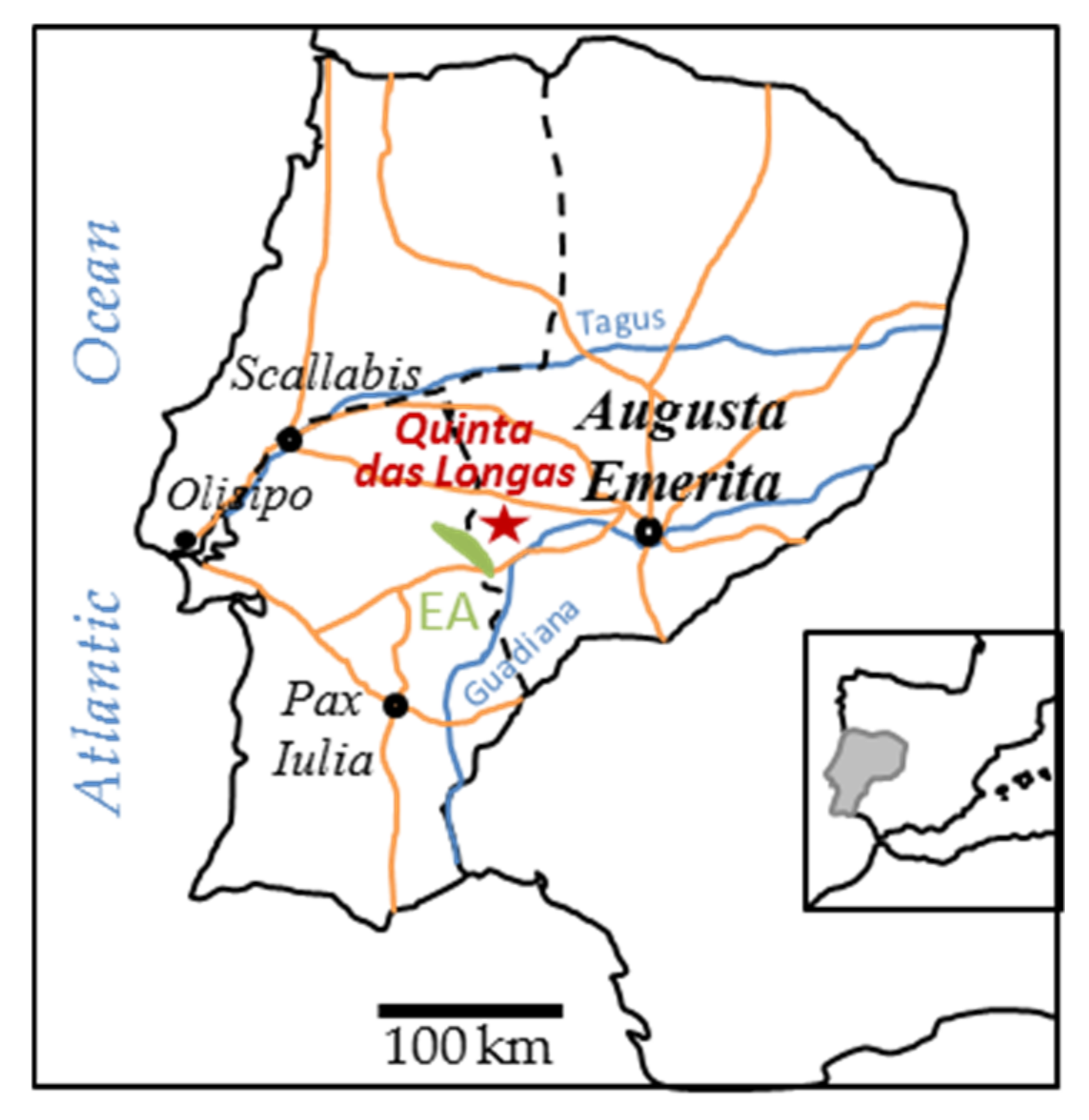
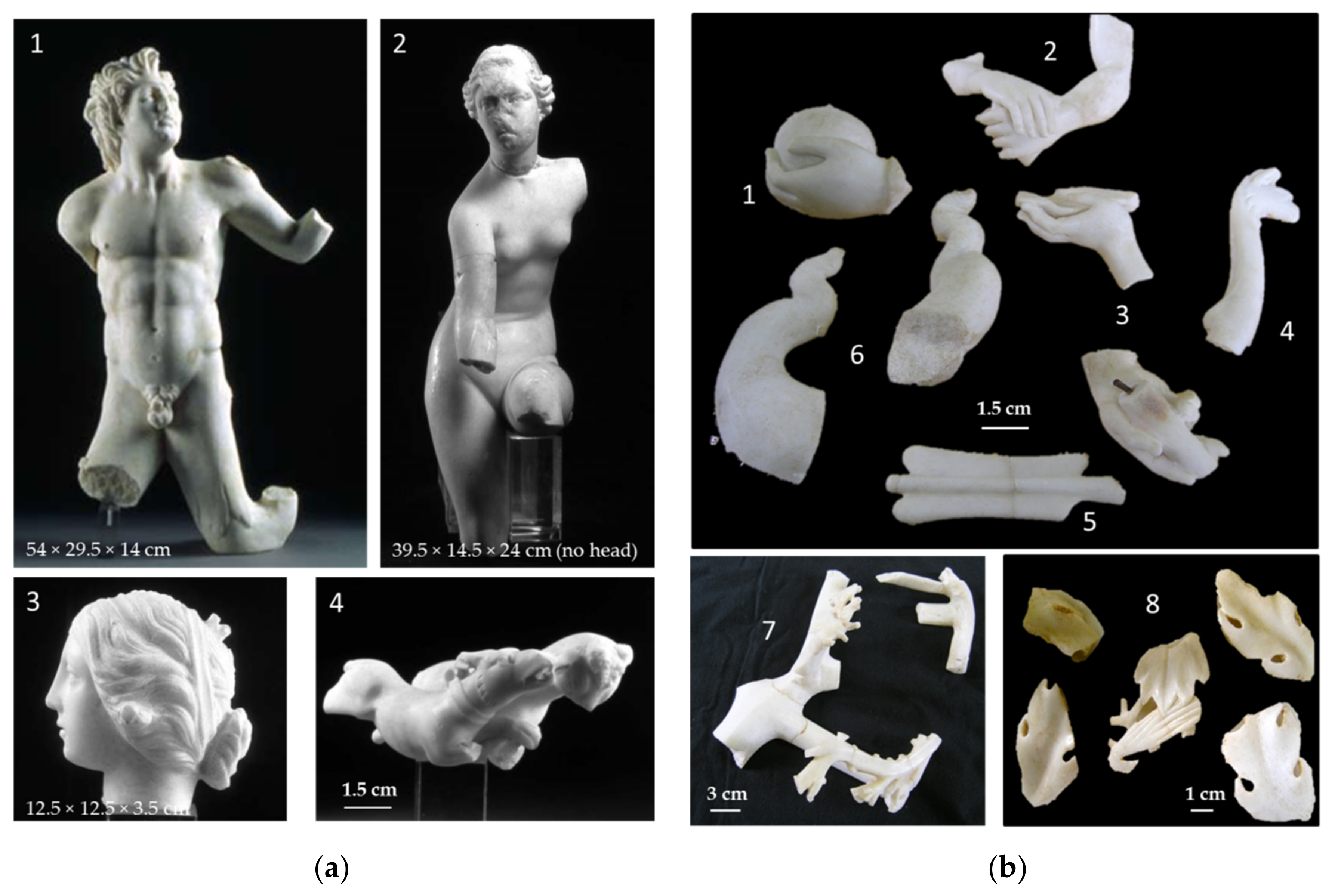
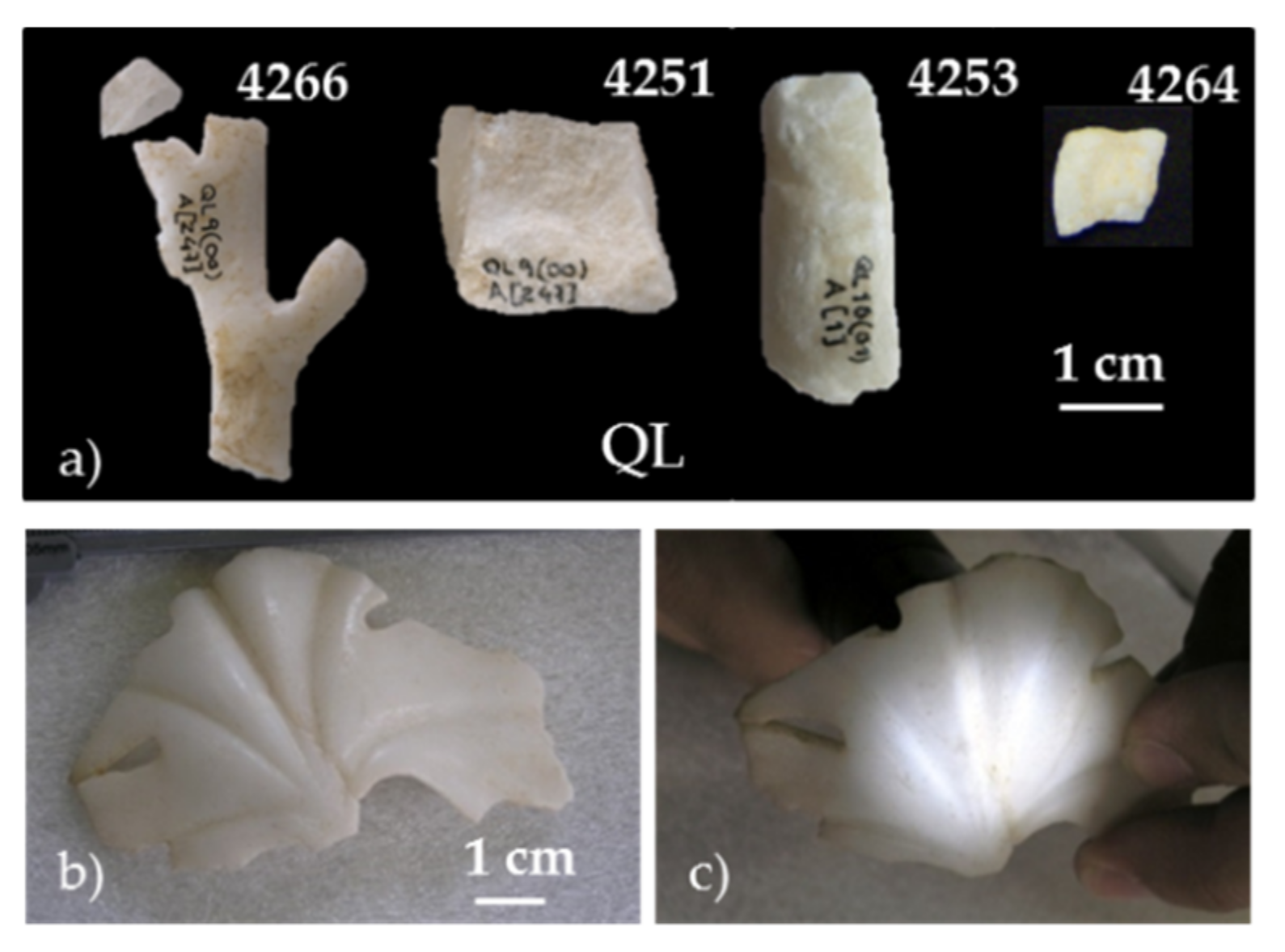


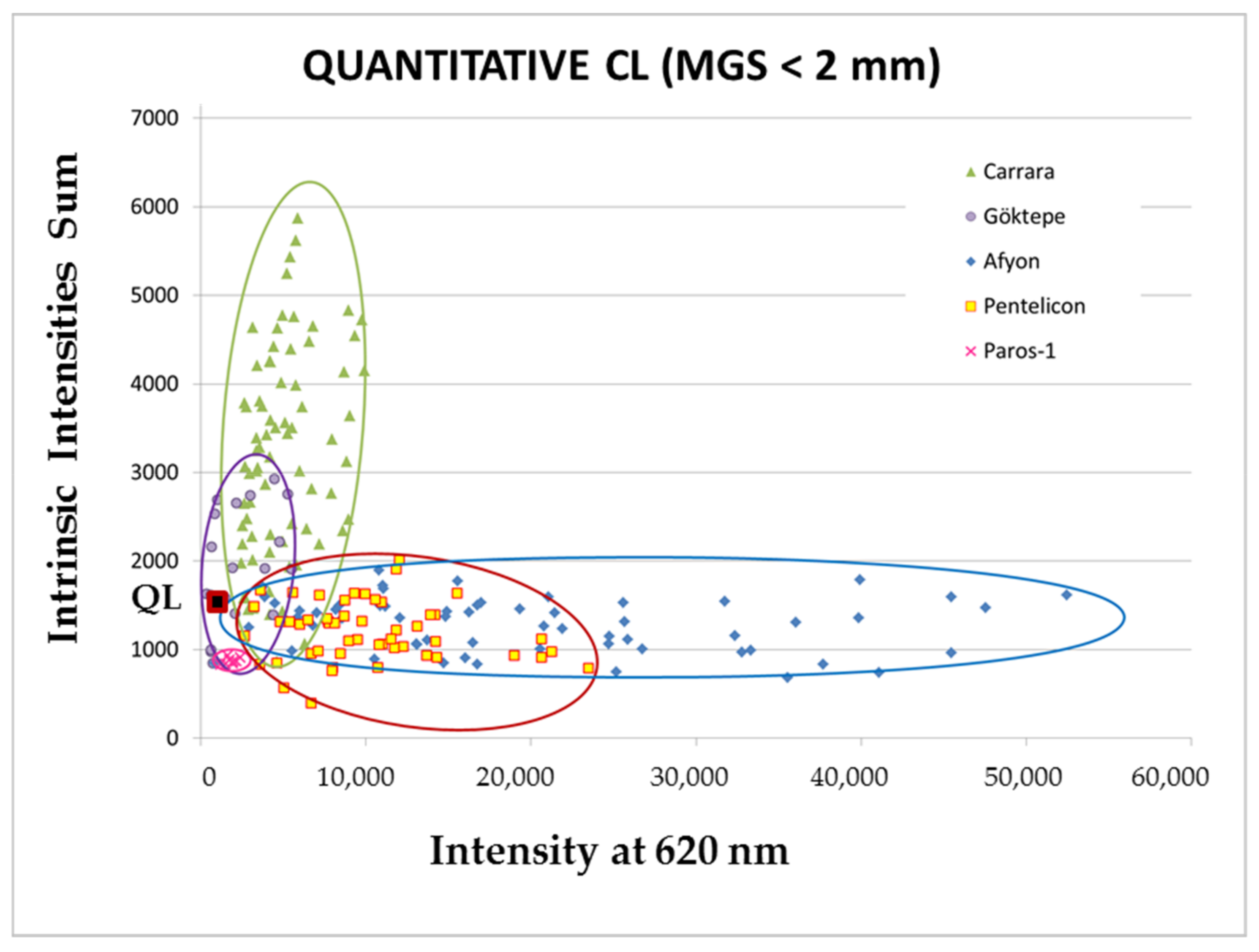

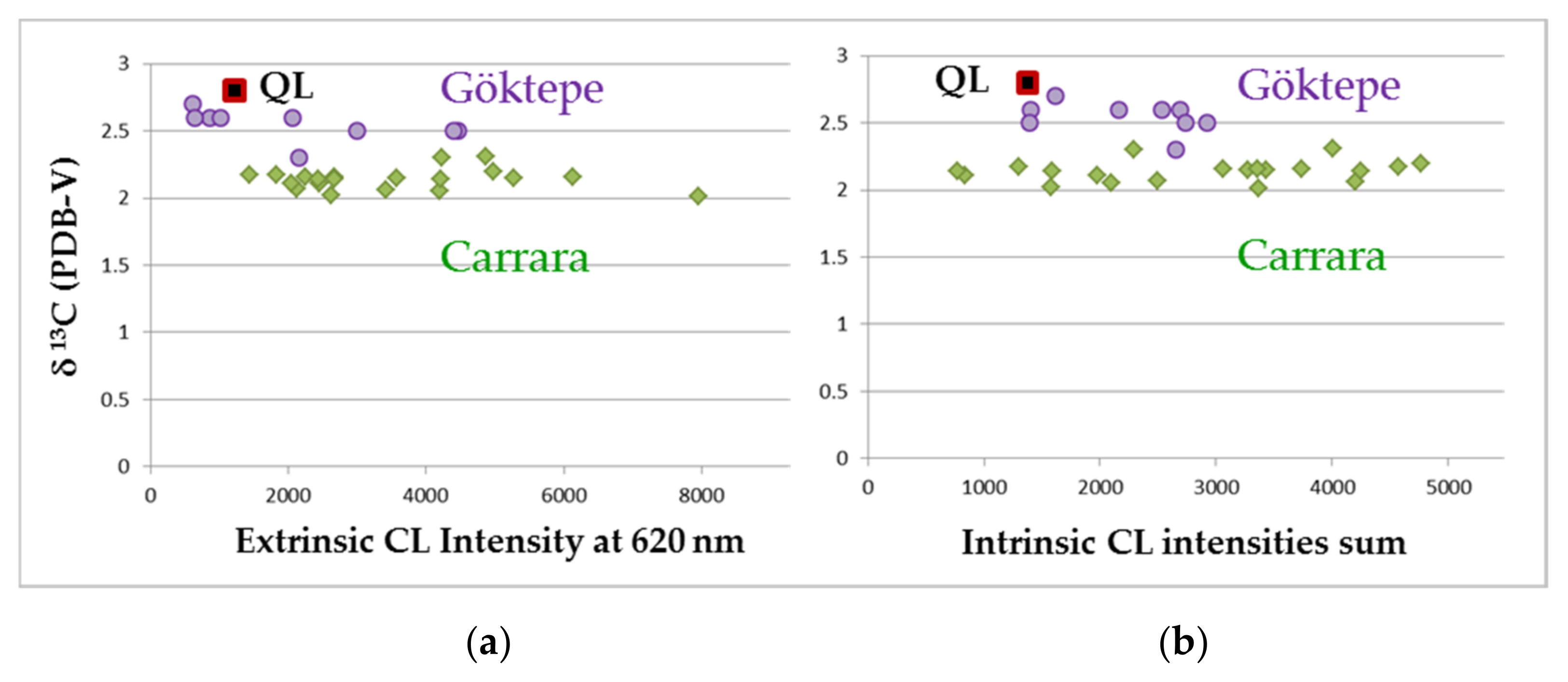
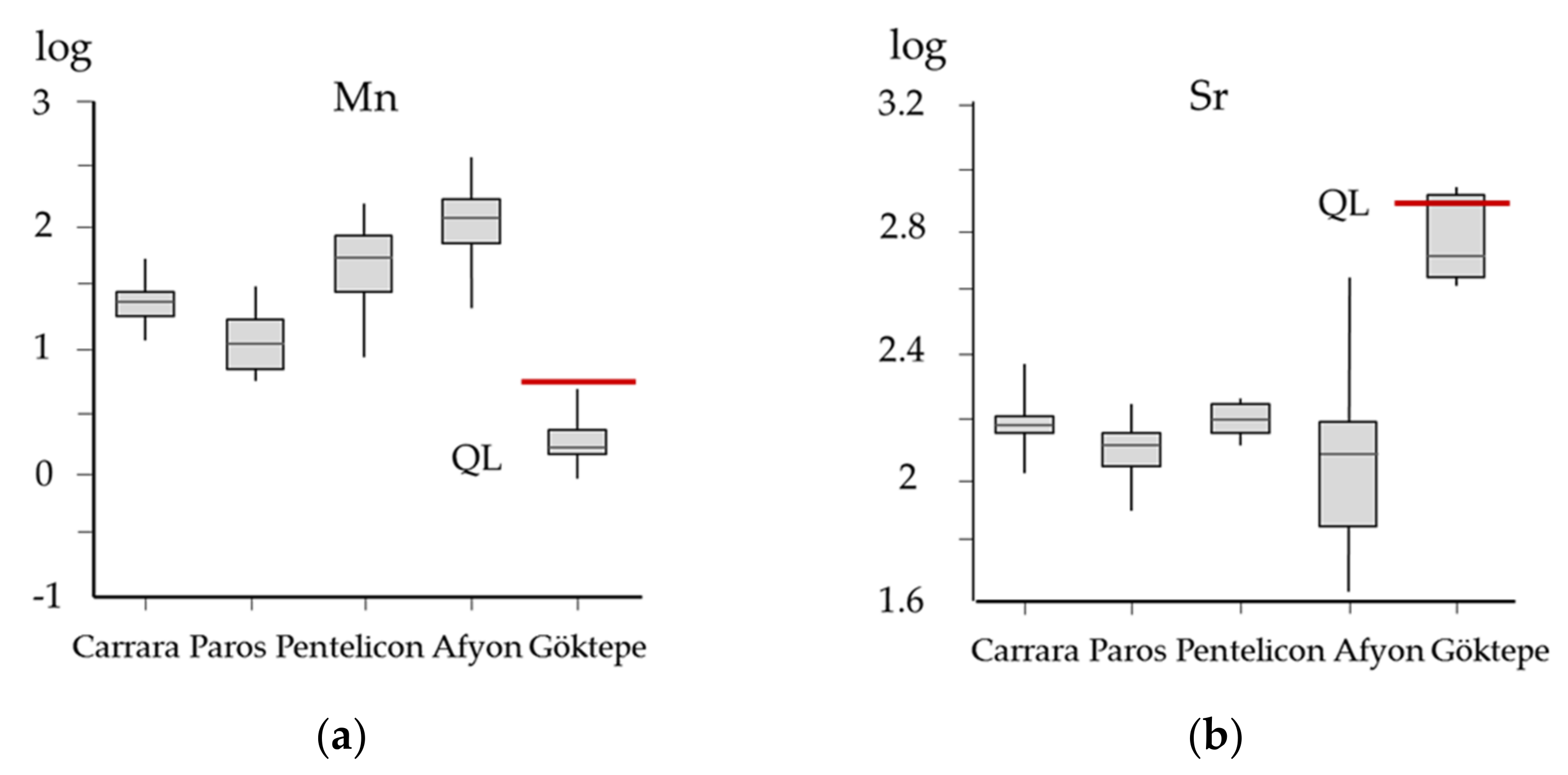
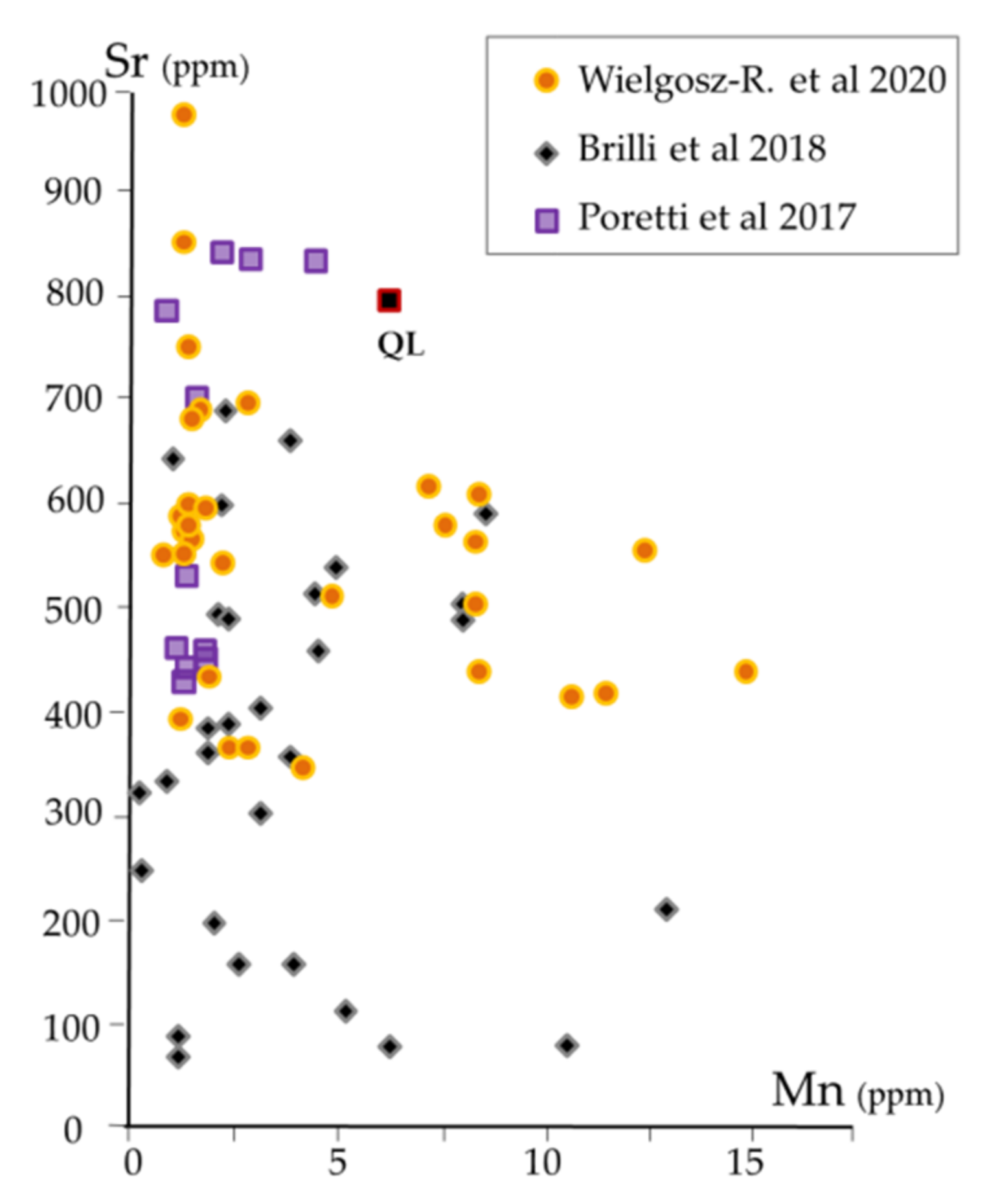
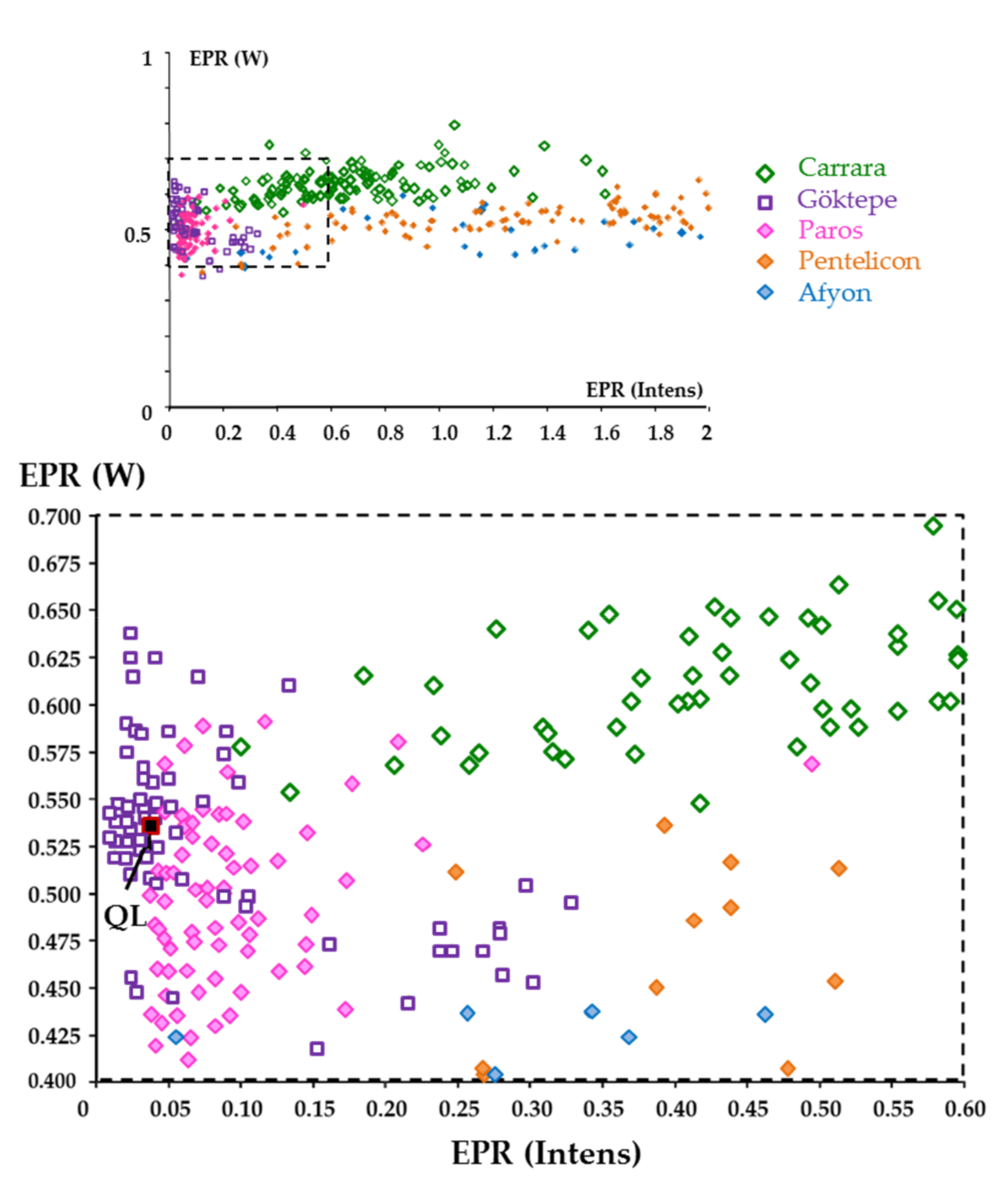
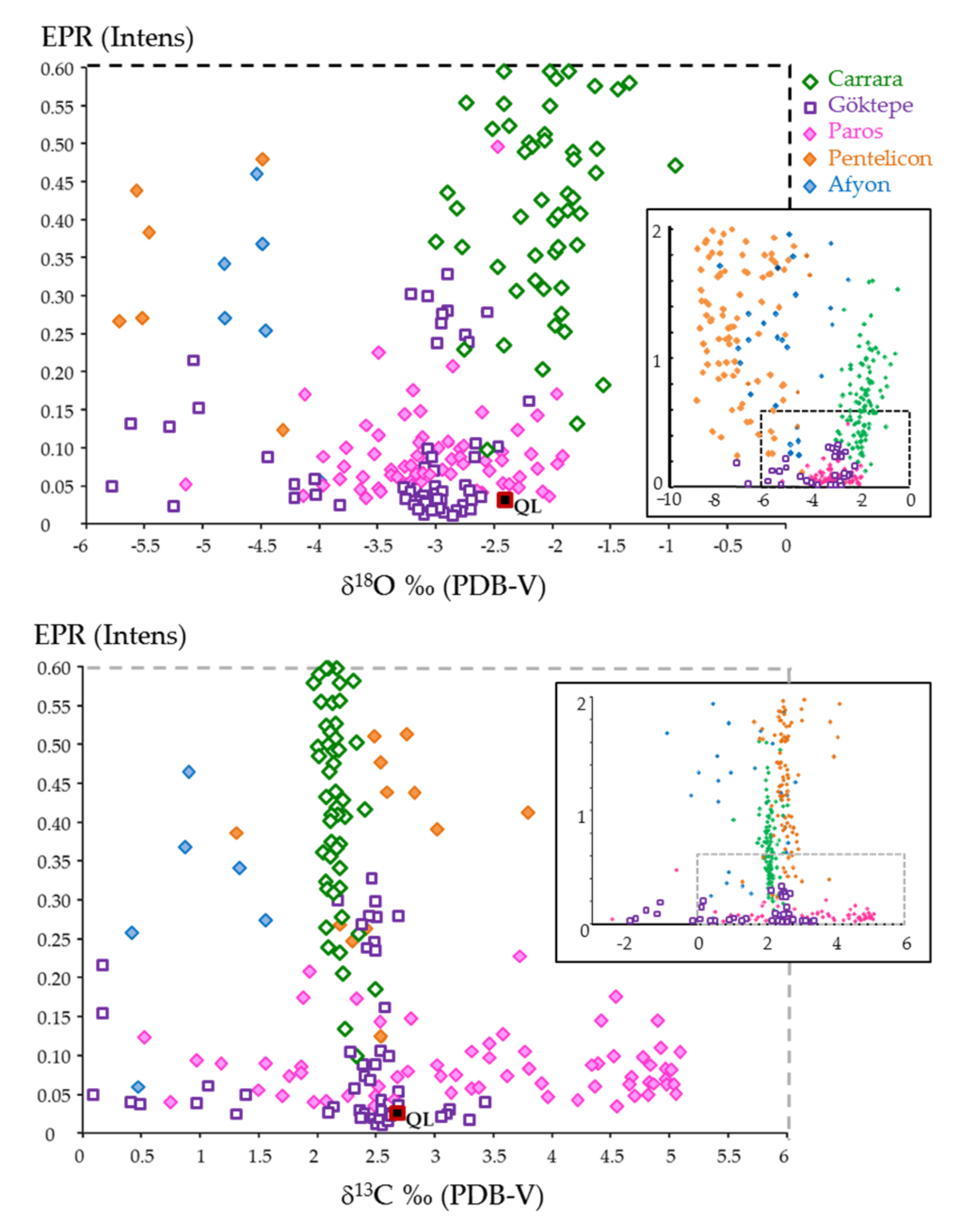
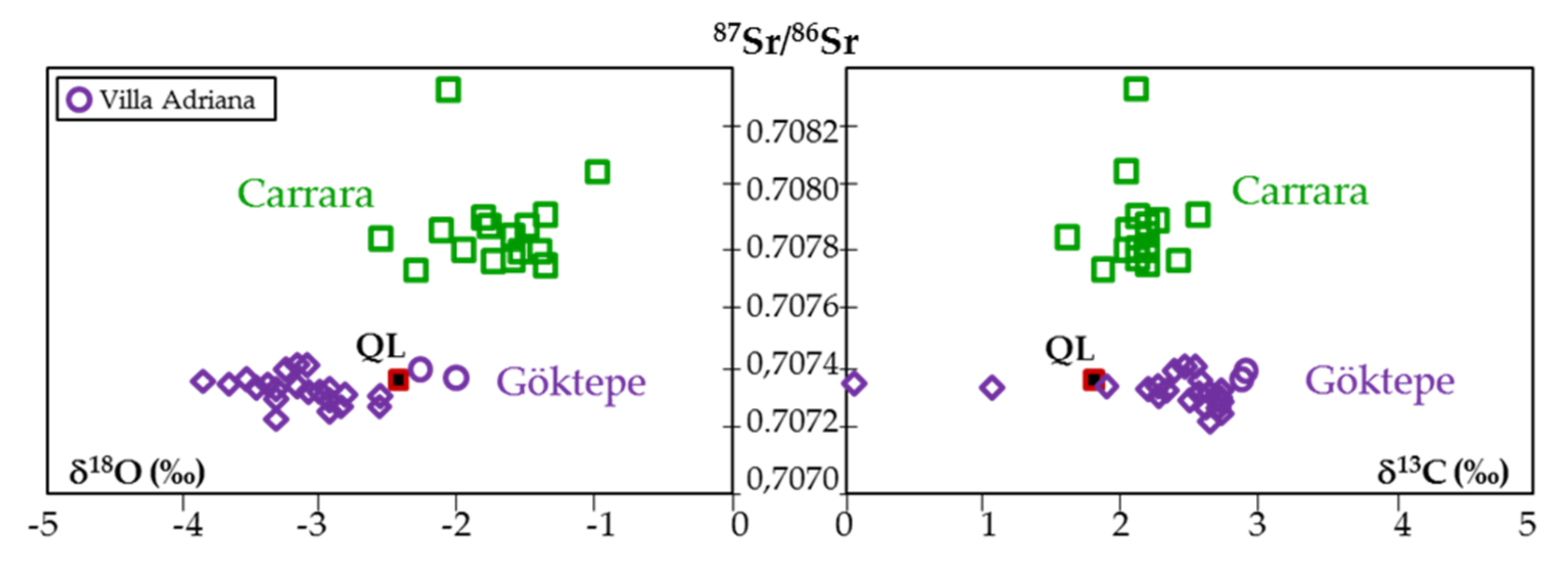
| MGS | MFS | GBS | Texture Fabric | Qualitative CL-Optical | CL-SEM Intensities Extrinsic (620 nm) /Intrinsic Sum | XRPD |
|---|---|---|---|---|---|---|
| 0.4 mm | Extremely fine 0.2 mm | Curved to Straight, occasionally to Embayed | Homeoblastic Mosaic Slightly strained (Crystallographic Preferred Orientation) | Low CL with dull domains | 1398/1470 | Calcite |
| δ13C ‰ (PDB-V) | δ18O ‰ (PDB-V) | EPR Intens | EPR Width | Sr ppm | Mn ppm | 87Sr/86Sr |
|---|---|---|---|---|---|---|
| +2.78 | −2.44 | 0.040 | 0.534 | 800 | 6 | 0.707358 |
Publisher’s Note: MDPI stays neutral with regard to jurisdictional claims in published maps and institutional affiliations. |
© 2021 by the authors. Licensee MDPI, Basel, Switzerland. This article is an open access article distributed under the terms and conditions of the Creative Commons Attribution (CC BY) license (https://creativecommons.org/licenses/by/4.0/).
Share and Cite
Lapuente Mercadal, M.P.; Nogales-Basarrate, T.; Carvalho, A. Mineralogical Insights to Identify Göktepe Marble in the Sculptural Program of Quinta Das Longas Villa (Lusitania). Minerals 2021, 11, 1194. https://doi.org/10.3390/min11111194
Lapuente Mercadal MP, Nogales-Basarrate T, Carvalho A. Mineralogical Insights to Identify Göktepe Marble in the Sculptural Program of Quinta Das Longas Villa (Lusitania). Minerals. 2021; 11(11):1194. https://doi.org/10.3390/min11111194
Chicago/Turabian StyleLapuente Mercadal, M. Pilar, Trinidad Nogales-Basarrate, and Antonio Carvalho. 2021. "Mineralogical Insights to Identify Göktepe Marble in the Sculptural Program of Quinta Das Longas Villa (Lusitania)" Minerals 11, no. 11: 1194. https://doi.org/10.3390/min11111194







